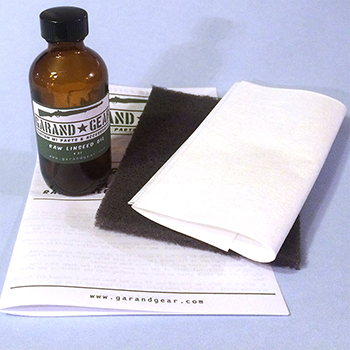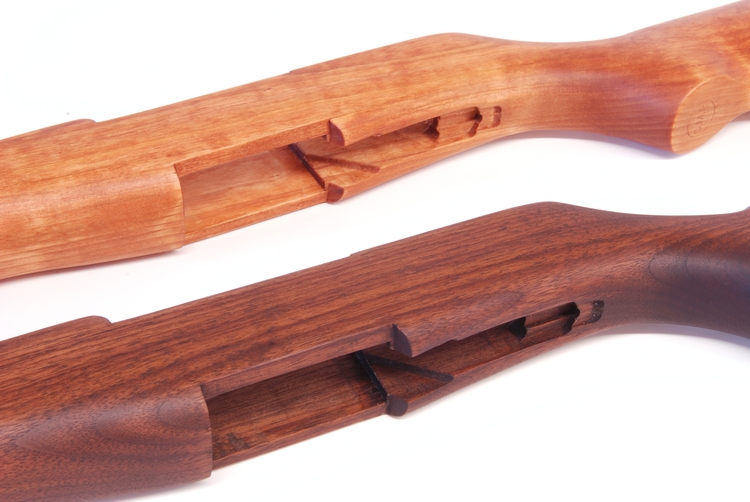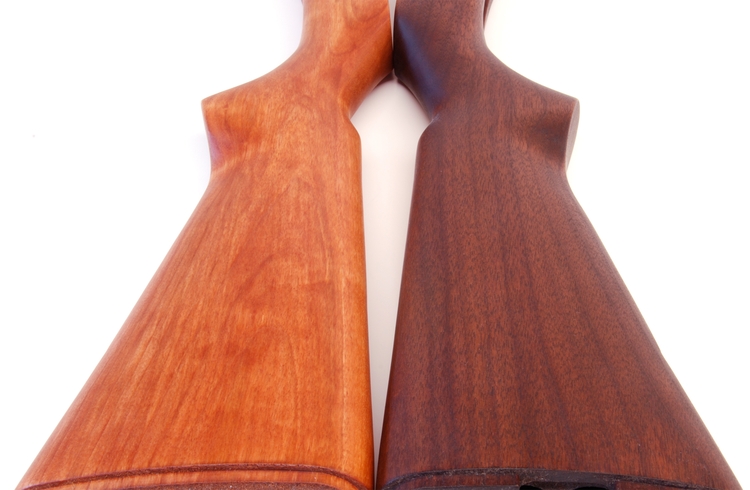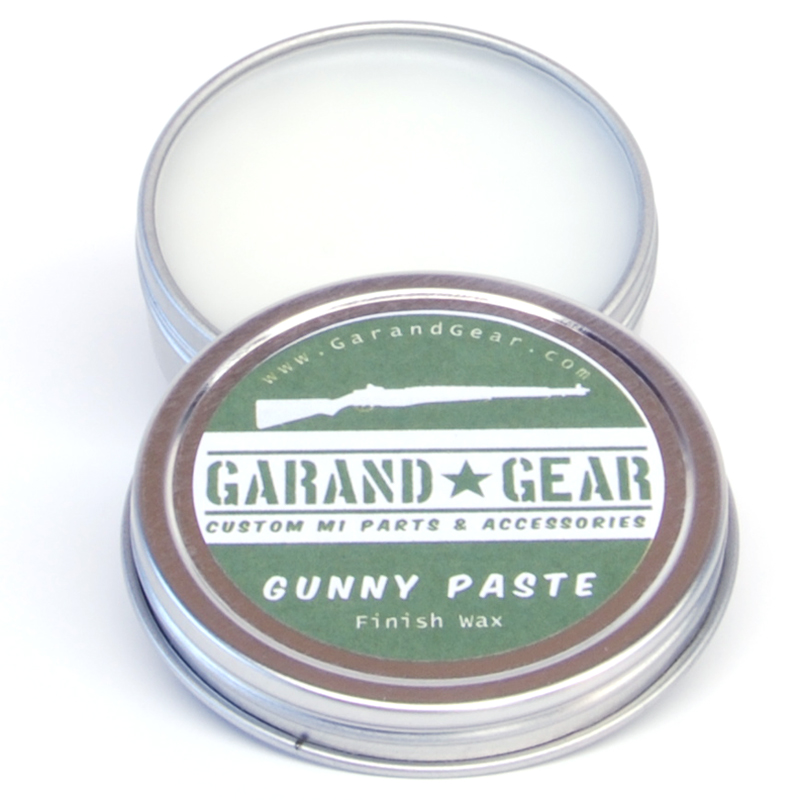Refinishing your M1 Garand Stock
New finishes can significantly improve the appearance of your M1 Garand. This article will cover one simple way to apply a new finish to your rifle stock. The rifle needs to be stripped and the wood prepared prior to applying a new oil to the wood. Start with the [ Detailed Striping your M1 Garand] and then the [M1 Garand Stock Stripping] article before continuing.
Oils? Stains? Varnishes?
The type of oil we want to apply to our rifle stocks are known as drying oils. This is a poor description of what occurs to the oil. The oils don’t actually dry by evaporation, instead, they cure by crosslinking in the presence of oxygen. The two oils that were used on the M1 during manufacturing were raw linseed oil and tung oil. Raw linseed oil is cold-pressed from the seed of the flax plant (Linum usitatissimum) and tung oil is pressed from the seed of the tung tree (Vernicia fordii). Each oil brings a unique character to the finished wood stock.
Varnish is a finish that is applied to wood to produce a hard glossy layer on the surface of the wood. Varnish might be colored or clear. Varnish is a more fragile finish and may not be suitable in all applications.
A stain is normally a pigment or coloring agent suspended in a chemical binder. The deep red color that older stocks develop is due to oxidation of the oil itself and is not a stain. The color of a stock with a stain applied can only fade with time when exposed to sunlight. The color of a stock treated with raw oil only improves with time and oxidation.
Linseed oil: So many options, only one real choice.
Linseed oil is probably the most confusing of oils to choose from. This is due to several variations of the oil that are commonly available. Linseed oil in its most pure form is pressed from the flaxseed and filtered. This oil is also known as flaxseed oil. This cold-pressed oil is rich in fatty acids. These fatty acids are responsible for the deep red patina that develops on our rifle stocks with age. The acid specifically responsible for this is linolenic acid. These fatty acids also slow the curing process making raw linseed oil one of the slowest curing oils available. This unprocessed oil is the one we want to use on our rifle stocks to produce an authentic patina with time.
Raw linseed oil sold by many companies today isn’t raw in the form we discussed above. This type of oil should be called refined linseed oil. The art community around the 15th century began to seek ways to convert raw linseed oil into a form that didn’t yellow or change colors with time. This was important because the artists didn’t want their colors to yellow with time. To address the problems of yellowing the method of refining the oil was developed.
A process was devised where the fatty acids could be extracted from the linseed oil. Refined linseed oil is slightly faster curing than its raw form but will not develop the red patina with time. To add to the confusion, products marketed by companies like the Sunnyside Corporation as “Pure Raw Linseed oil” are actually “Pure Refined Linseed oil”. These oils are solvent extracted from the flaxseed and the fatty acids are removed.
Before you purchase a raw linseed oil product, verify with the manufacturer that the oil has NOT been refined. A form of refined linseed oil called “Bleached linseed oil” is sometimes available at art stores. This is a refined oil that has undergone additional refining to allow it to flow better in paint.
Boiled linseed oil is the form that most users are familiar with. This oil is commonly available at all hardware outlets today. Boiled linseed oil starts out as refined linseed oil with the fatty acids removed. Metallic additives, known as “Siccatives” are added to the oil to speed up the crosslinking process. These additives can be Cobalt or manganese salts. Zirconium, Calcium, or Zinc salts are also used. In some cases, Lead and barium salts are sometimes added. This allows the oil to cure in 12-24 hours. Boiled linseed oil will never develop the deep red patina that we see on USGI stocks today.

Tung Oil.
Tung oil is likely the first oil ever specifically processed to preserve the wood. The Chinese used it over 2400 years ago to preserve their works. The term “Tung” is a very old Chinese term meaning “of the heart”. The leaves of the tung oil tree [Vernicia fordii] have a heart shape to them. At about three years of age, the tung tree begins producing nuts which are harvested and pressed for their oil. Each seed produces about 18-24% oil by weight. This oil is filtered and not refined.
Tung oil undergoes a very different cross-linking process than does linseed oil and has a much faster cure time. Tung oil does not contain linolenic acid and will not generate the same red patina that raw linseed oil does. Tung oil does contain about 9% linoleic acid which can provide a slight yellow/red tint with time. However, the color will not be to the same degree that linolenic acid does. Tung oil provides a superior water-resistant barrier when compared with Linseed oil.
Tung oil is our recommended oil when a rifle stock is likely to be in the field for extended periods of time. A tung oil finish is durable and has been field-tested for over 2000 years. A finishing wax can always be applied to the stock to increase its ability to reject water intake in high humidity conditions. Be sure to check out our paste wax if you plan on operating in wet conditions for extended periods of time.
Like linseed oil, there are many products on the market that call themselves “Tung oil finishes”. These are normally stains and contain very little if any real Tung oil. These products are poor substitutes for the real thing. Don’t cure your Tung Oil stock in direct sunlight. Surface frosting can occur. A warm place is all that is needed.
Getting Started.
Now that you’ve chosen which oil finish you wish to use, we’ll cover the process of correctly applying that oil to your stock. If you want to start over with a stripped stock be sure to read the article on that process before continuing. We’re going to assume that the stock has been stripped or otherwise prepared and sanded by this time. If you are applying a touch-up coat of oil to an existing finish be sure to clean the surface of the stock well to remove any residues, waxes, or other surface contaminants that might prevent the oil from soaking into the stock.
1Setup a workspace such that your stock can sit without being contaminated with dust or another airborne particulate. Do a final inspection of the stock for any areas that need work. This is the last chance to do that work without stripping the stock and starting over. If this is a new stock do a trial fit with your receiver and trigger assembly to verify that no areas are binding.
2Open your oil kit and remove the contents. There should be a 4oz bottle of oil, a microfiber rag, a 3M finishing pad, and instructions. If you are sensitive to nut oils be sure to wear appropriate safety gear.

3The raw oil may be applied as-is or you may want to pour some oil aside and thin the first two coats using 50% oil and 50% Mineral spirits or Turpentine. Thinning the first two coats of oil helps the oil penetrate deeper into the stock.
Rags soaked in drying oils can self-combust. The curing process generates heat. If the rags are tightly packed in an enclosed space they will catch fire! Always lay your rags out flat in an open and safe area when not in use! When disposing of rags submerge them in water.
4Saturate a small piece of lint-free cloth with the oil and apply liberally to the wood. Completely saturate the wood with the oil. Be sure to oil the entire stock, including the interior surfaces. Hang the stock from a wire to allow excess oil to drip from the stock.
5Let the oil sit for 1 hour. After an hour use the microfiber rag provided to wipe down the entire stock and handguards. Any oil left on the surface should be wiped away. Any areas of the wood that are glossy should be wiped down again. Any glossy areas that develop in the next 24 hours should be wiped down. The stock should never feel tacky or sticky.
6Allow the stock to sit for 24 hours. After 24 hours rub-down the stock using the provided 3M finishing pad. This step helps assure a smooth finish and removes any raised grain that might have occurred.

[First coat of Raw Linseed Oil]
7Apply 2 additional coats of the oil over the next two days. Each time wiping off the stock after an hour and sanding with the finishing pad after 24 hours.
8Switch to 100% oil now If you had been using a thinned oil in the previous coats. If you’ve been using 100% oil continue to do so.
9Apply the oil to the stock in the same manner as before. (Note: If the temperature is below 60F, warm the oil container before use. The oil can be heated to 140F (warm to the touch) for optimum penetration.) After 1 hour wipe off any excess oil. The abrasive finishing pad is no longer used at this point.
10How long to wait before reassembly depends upon which oil you used. If you used tung oil then the rifle should be allowed to sit for two to three days before handling the stock. Raw linseed oil should be allowed to sit for 2 to 3 weeks at a minimum at temperatures above 70 degrees. If the stock is cold it will take longer for the oil to crosslink and cure.

[Raw Linseed Oil Finish on Birch and Walnut]

[One week after Finishing]
[Birch – Walnut]

[Final Assembly – Raw Linseed Oil – Birch Stock]
Finishing Up:
Natural oil finishes are moderately water-resistant on their own. Tung oil is superior to linseed oil in terms of its ability to repel water. If you are going to operate your M1 in high humidity areas you will want to apply a finish wax to the stock after it’s cured to limit the uptake of water. If your stock takes in too much water it can swell slightly and cause the internal components to occasionally rub or bind.
The traditional paste wax (also known as Gunny Paste) that has been used for years was based on beeswax mixed with either tung oil or linseed oil and thinned with a solvent. While effective, this traditional wax has a few pitfalls that should be noted. Exposure to sunlight will break down the beeswax with time and the natural acids will slowly assault your finish — over the years. Museums and antique dealers have long ago moved away from beeswax and switched to microcrystalline-based wax products. We offer a microcrystalline-based finish wax that also blocks UVA/UVB light before it reaches your wood finish. When ultraviolet light strikes a wood finish it breaks un-reacted double bonds in the oil. This causes the finish to break down and fade. Our UVA/UVB blocker is designed to absorb much of that energy before it reaches your finish.
Our Gunny paste contains no finishing oils allowing it to be applied to any type of wood finish. Microcrystalline wax is superior to natural waxes because it is PH neutral and doesn’t contain any acids. Our wax has a melting point of 175F whereas beeswax will get sticky around 144F
Applying the wax:
1 The stock should be fully cured prior to adding your finish wax. If you used Tung oil we recommend you wait at least one week before applying the wax. If you used linseed oil we recommend you wait one month. If you are going to apply the wax to an existing finish we recommend that you clean the stock first to remove any surface contamination or older waxes that might be present. [Cleaning your M1 Garand]
2 Take a small piece of clean cloth and rub some wax onto it. Using a circular motion apply the wax to the stock. Only a very small amount is needed. If the stock is broken down apply the wax to the inside areas as well. Pay special attention to areas of end grain. The majority of moisture moves into and out of your stock in these areas.
3 Wait for a minute or two for the solvent oil to evaporate and using a new clean piece of cloth, buff out the surface wax with a circular motion. A thin layer of wax is all that is needed to provide the water and sun protection we need. Two coats are normally sufficient to protect the stock.
4We recommend a touch-up coat of wax once a year if the rifle is being used frequently.

